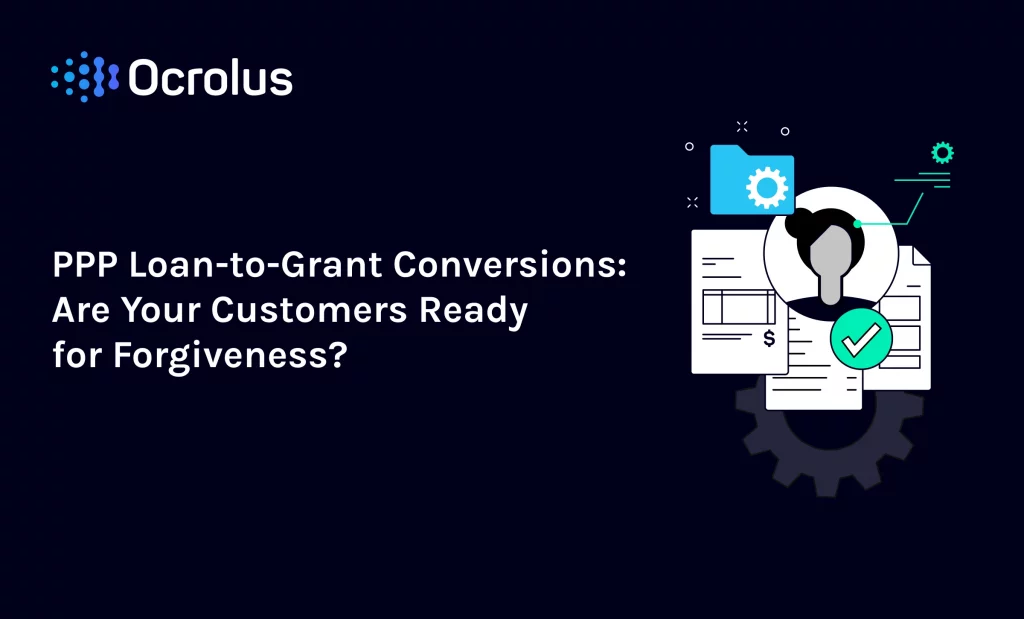This website uses cookies so that we can provide you with the best user experience possible. Cookie information is stored in your browser and performs functions such as recognising you when you return to our website and helping our team to understand which sections of the website you find most interesting and useful.
PPP Loan-to-Grant Conversions: Are Your Customers Ready for Forgiveness?

Somewhat lost this past month in the fervor of the two SBA PPP funding events is the upcoming day of reckoning when participants will have the ability to convert the low-interest loans into forgivable grants. To do so, businesses will need to document that the funds were used primarily for payroll and overhead (rent/utilities.)
As with the PPP application process, the loan forgiveness conversion is somewhat confusing. For lenders, here are five important procedural issues to consider:
The documentation required will be different than the documents obtained when funding the original loans, including updated payroll reporting, utility bills, rent checks, mortgage interest payments and bank statements. These will all be new or updated documents containing post-funding payroll and company spend. It will not be enough to simply pull data from bank accounts;,there will be a requirement for a documented audit trail. Lenders can prepare for the document on-slaught, but the documents themselves won’t be ready for review until the end of the eight-week period.
Small business customers will have a lot on the line. This summer they will be looking to remove the loan balance from their balance sheets and will look favorably on the lender/originator that first secured the PPP loan and then expediently converted the loan to a grant. Whether the business was an existing customer or became a customer as a result of the program, the biggest benefit to lenders with this program could be seen as being low-cost customer acquisition.Some may even look at the origination fee and say that this was revenue positive customer acquisition.
Loan conversion will not be an all or nothing proposition. While some borrowers have expressed frustration over the rules, the program was developed to encourage employee stability. Even if, for example, a borrower used less than 75% of the funds to meet payroll, the portion for payroll that can be documented may be forgiven.
Payroll documentation will be key. In Ocrolus’ history of document indexing and processing, payroll reports have been the most difficult documentation for lenders to manage, because there is no set structure to the documents and data fields as there is with federal tax forms. In our experience with the PPP funding–Ocrolus provided the documentation engine for over 150K PPP loans, with more than a million pages of payroll and tax documents–most lenders will be ill-prepared to serve their customers without a document ingestion system. It will be vitally important for lenders to have a document digitization strategy in place.
Lenders need to consider the long-term borrower relationship. To comply with the SBA guidelines, lenders will have sixty days to provide a loan forgiveness decision to their customers (see sidebar below.) While that may seem like a long time–and 60 days will seem like an eternity to the small business owner–the two-month timeline is a requirement but hardly a best practice for customer satisfaction. In this most challenging business climate, a small business owner will be anxiously awaiting confirmation that their loan balance is forgiven. Borrowers will view the lender that acts as quickly in rendering the grant decision as they acted for the loan approval, as a long-term funding partner.
Time to Prepare Rather than React
What can lenders do to prepare for customer requests for PPP loan-to-grant conversion? Thankfully, there is time to build a document ingestion system that mitigates the need to scramble to serve customers. If the two loan application tranches taught the lending community anything, it is the need to pivot on underwriting and documentation processes, both in handling document types and in adjusting to fluctuating document volume.
# # #
Sidebar:
From the Treasury Department PPP Fact Sheet
How much of my loan will be forgiven?
You will owe money when your loan is due if you use the loan amount for anything other than payroll costs, mortgage interest, rent, and utility payments over the eight weeks after getting the loan. Due to the likely high subscription, it is anticipated that not more than 25% of the forgiven amount may be for non-payroll costs.
You will also owe money if you do not maintain your staff and payroll:
- Number of Staff: Your loan forgiveness will be reduced if you decrease your full-time employee headcount.
- Level of Payroll: Your loan forgiveness will also be reduced if you decrease salaries and wages by more than 25% for any employee that made less than $100,000 annualized in 2019.
- Re-Hiring: You have until June 30, 2020 to restore your full-time employment and salary levels for any changes made between February 15, 2020 and April 26, 2020.
How can I request loan forgiveness? You can submit a request to the lender that is servicing the loan. The request will include documents that verify the number of full-time equivalent employees and pay rates, as well as the payments on eligible mortgage, lease, and utility obligations. You must certify that the documents are true and that you used the forgiveness amount to keep employees and make eligible payments. The lender must make a decision on forgiveness within 60 days.





